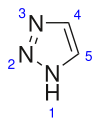| |||
| Names | |||
|---|---|---|---|
| Preferred IUPAC name 1H-1,2,3-Triazole | |||
| Other names 1,2,3-Triazole | |||
| Identifiers | |||
| CAS Number | |||
| 3D model (JSmol) | |||
| ChEBI | |||
| ChemSpider | |||
| ECHA InfoCard | 100.128.405 | ||
| EC Number |
| ||
| PubChem CID | |||
| UNII | |||
| CompTox Dashboard (EPA) | |||
InChI
| |||
SMILES
| |||
| Properties | |||
| Chemical formula | C2H3N3 | ||
| Molar mass | 69.0654 | ||
| Appearance | colorless liquid | ||
| Density | 1.192 | ||
| Melting point | 23 to 25 °C (73 to 77 °F; 296 to 298 K) | ||
| Boiling point | 203 °C (397 °F; 476 K) | ||
| Solubility in water | very soluble | ||
| Acidity (pKa) | 9.4 | ||
| Basicity (pKb) | 1.2 | ||
| Hazards | |||
| GHS labelling: | |||
| Pictograms | 
| ||
| Signal word | Warning | ||
| Hazard statements | H315, H319, H335 | ||
| Precautionary statements | P261, P264, P271, P280, P302+P352, P304+P340, P305+P351+P338, P312, P321, P332+P313, P337+P313, P362, P403+P233, P405, P501 | ||
| Related compounds | |||
| Related compounds | 1,2,4-triazole imidazole | ||
| Except where otherwise noted, data are given for materials in their standard state (at 25 °C , 100 kPa).
| |||
1,2,3-Triazole is one of a pair of isomeric chemical compounds with molecular formula C2H3N3, called triazoles, which have a five-membered ring of two carbon atoms and three nitrogen atoms. 1,2,3-Triazole is a basic aromatic heterocycle.
Synthesis
The unsubstituted ring can be produced by an oxidative coupling of glyoxal, hydrazine and sodium nitrite.
A wide range of methods exist for forming substituted 1,2,3-triazoles. These include the Banert cascade or the azide alkyne Huisgen cycloaddition in which an azide and an alkyne undergo a 1,3-dipolar cycloaddition reaction. Under thermal conditions, regioselectivity is substrate dependent. Selectivity can be increased with metal catalysts, which have the added benefit of reacting without excessive or extensive heating. Copper catalyzed cycloadditions favor 1,4-disubstituted triazoles, Ruthenium catalyzed cycloaddition favor 1,5-disubstituted triazoles. This chemistry was expanded by Zhu et al. in 2018 wherein they report a two-step sequence from a terminal alkyne to 4-cyano 1,5-disubstituted triazoles.
Properties
The 2H-1,2,3-triazole tautomer is the major form in aqueous solution. It is a surprisingly stable structure compared to other organic compounds with three adjacent nitrogen atoms. However, flash vacuum pyrolysis at 500 °C leads to loss of molecular nitrogen (N2) leaving a three-member aziridine ring. Certain triazoles are relatively easy to cleave due to ring–chain tautomerism. One manifestation is found in the Dimroth rearrangement.
Applications
1,2,3-Triazole finds use in research as a bioisostere in medicinal chemistry and building block for more complex chemical compounds, including pharmaceutical drugs such as mubritinib and tazobactam.
References
- ^ "1,2,3-triazole - an overview". Comprehensive Heterocyclic Chemistry. 1984.
- Gilchrist, T.L. (1987). Heterocyclic chemistry. Prentice Hall Press. ISBN 0-582-01421-2.
- Song, Lei; Ang, Hwee Ting; Senthilperumal, Jagadeesan; Kanusu, Umamaheswara Rao; Venugopal, Sivasankaran; Rangarajan, Naveen; Krishnamoorthy, Shivasankar; Dubbaka, Srinivas Reddy; O’Neill, Patrick; Wu, Jie (12 March 2024). "1,2,3-Triazole Synthesis: Development of Safe and Effective Batch and Continuous Manufacturing Processes". Organic Process Research & Development. doi:10.1021/acs.oprd.4c00020.
- Krivopalov, Victor P; Shkurko, Oleg P (30 April 2005). "1,2,3-Triazole and its derivatives. Development of methods for the formation of the triazole ring". Russian Chemical Reviews. 74 (4): 339–379. doi:10.1070/RC2005v074n04ABEH000893.
- Liu, P.; Clark, R.; Zhu, L. (2018). "Synthesis of 1‑Cyanoalkynes and Their Ruthenium(II)-Catalyzed Cycloaddition with Organic Azides to Afford 4‑Cyano-1,2,3-triazoles". J. Org. Chem. 83 (9): 5092–5103. doi:10.1021/acs.joc.8b00424. PMID 29630830.
- Albert, Adrien; Taylor, Peter J. (1989). "The tautomerism of 1,2,3-triazole in aqueous solution". Journal of the Chemical Society, Perkin Transactions 2 (11): 1903–1905. doi:10.1039/P29890001903.
- Bonandi, E.; Christodoulou, M. S.; Fumagalli, G.; Perdicchia, D.; Rastelli, G.; Passarella, D. (2017). "The 1,2,3-triazole ring as a bioisostere in medicinal chemistry". Drug Discov Today. 22 (10): 1572–1581. doi:10.1016/j.drudis.2017.05.014. hdl:11380/1153568. PMID 28676407.

